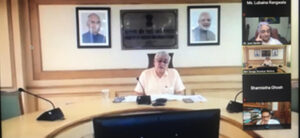Stakeholder Workshop on Developing a Disaster Resilience Action Plan for Gangtok
Integrated Research and Action for Development (IRADe) in collaboration with Sikkim State Disaster Management Authority (SSDMA) organized a Stakeholders’ workshop on “Developing Disaster Resilience Action Plan, Gangtok city, Sikkim”.
New Delhi, September 30, 2020: Integrated Research and Action for Development (IRADe) in collaboration with Sikkim State Disaster Management Authority (SSDMA) organized a Stakeholders’ workshop on “Developing Disaster Resilience Action Plan, Gangtok city, Sikkim”.
Stakeholder consultation was conducted to share the results and findings of the project on Developing Disaster Resilience Action Plan for Gangtok which is lead by a IRADe, in association with North Eastern Space Applications Centre (NESAC) and G B Pant National Institute of Himalayan Environment (GBPNIHESD-SRC). The project is funded by National Mission on Himlayan Studies (NMHS) of the Ministry of Environment, Forests & Climate Change (MoEFCC), Government of India..
Prof. Vinod Sharma, Vice-Chairman, Sikkim State Disaster Management Authority (SSDMA) was the Chief Guest. Mr P N Sherpa, Relief Commissioner –Cum-Secretary Land Revenue and Disaster Management Department, Govt. of Sikkim, was the Guest of Honour, for this workshop.
Prof Jyoti K Parikh, Executive Director IRADe, in her welcome address emphasised on the importance of Disaster resilience in the vulnerable North Eastern Himalayan cities. She highlighted that the use of Remote sensing and GIS is crucial to develop action plans which help in emergencies and disasters. She explained that the ongoing Action Plan for Gangtok focuses on ward level resilience and can be a good case study for other Himalayan cities.
Prof. Ajit Tyagi, Senior advisor, IRADe gave opening remarks followed by a presentation to set the context of the ongoing project in Gangtok and moderated the panel discussion on developing Disaster Resilience Action Plan.
Dr PLN Raju , Director, NESAC highlighted the importance of GIS and Remote sensing mapping. He stressed on the need for a mechanism to update the latest data from time to time as cities are growing faster. He concluded by affirming the future assistance of NESAC to the government and the local communities to provide a comprehensive solution to tackle Disaster risks in Gangtok and other cities. He emphasised that the application of this project will be most important for the local communities.

Prof. Vinod Sharma thanked IRADe for this initiative and said that this is a much-needed study. A collaboration between Research organisations and Government organisations is the need of the time, and this project sets an excellent example of IRADe, NESAC, GBPNIHESD-SRC, GSI, SSDMA and others working together. He highlighted that the state administration is sensitive about incorporating resilience actions in the implementation plans of the city. He suggested forming a committee of experts so that similar plans can be proposed for other cities based on the ongoing Gangtok project model.

Mr PN Sherpa informed about the latest technology tools like GIS and Remote sensing used by the Govt of Sikkim. Gangtok is one of the fastest-growing municipalities in India where Climate change is a significant challenge. He suggested that the Early warning systems for Disasters Risk Resilience should further evolve into Early Actions. While the level of disaster risk exposure can be reduced by regional and urban planning, the resilience of a society depends on physical, social and economic factors that are also the focus of sustainable development strategies. He appreciated IRADe and partners for taking the initiative for developing the Disaster Resilience Action Plan for Gangtok and expressed his happiness to note that considerable progress has been made so far. He assured that SSDMA shall continue to provide support and cooperation to IRADe.
Mr Hem Kumar Chettri, Chief Municipal Commissioner, Gangtok Municipal Corporation (GMC) implied on the ground level implementation of such Action Plans and urged the need of training Municipal officials on the same. He stressed on the capacity building of the Urban Local Body officials and the community at large.
Mr Phigu Bhutia, Additional Director, SSDMA welcomed the project and requested that the database developed as part of the project should be made accessible to SSDMA for further updation. Mr Bhutia also spoke about data interoperability and stressed that the GIS platform codes should be shared with SSDMA for replication in other towns and cities. He also added that SSDMA is planning to have a data repository for use of stakeholders and line departments. He further gave assurance that SSDMA is open for collaborations and partnerships to enhance the resilience of the state.
Mr Rohit Magotra, Deputy Director of IRADe, made a thematic presentation on the features of Disaster Resilience Action Plan project progress which was followed by presentations from Dr Diganta Barman (NESAC) and Dr Rajesh Joshi (GBPNIHESD-SRC).
The stakeholder panelists included Mr Hem Kumar Chettri, Chief Municipal Commissioner, Gangtok Municipal Corporation (GMC); Mr Phigu Bhutia, Additional. Director, SSDMA; Prof. Subashisa Dutta, IIT, Guwahati; Shri Lalit Mohan, Senior Geologist, GSI-Gangtok; Dr G N Raha, Director, IMD, Gangtok; Dr Surajit Baruah, former State Project Manager, UNDP; Dr Saurabh Baruah, Chief Scientist, CSIR Northeast Institute of Science and Technology, Jorhat, Assam; and Dr Mustafa Ali Khan, Team Leader, SCA-Himalayas, Swiss Cooperation Office India.
The stakeholder consultation proceedings shall be shared further with the SSDMA and other stakeholders for their review and feedback. The project also plans to conduct community level consultations with the local communities and representatives for refining the action plans. The project is first of its kind in developing hazard risk maps on the scale of 1:4000 and will help in building disaster and climate resilience of Gangtok.

